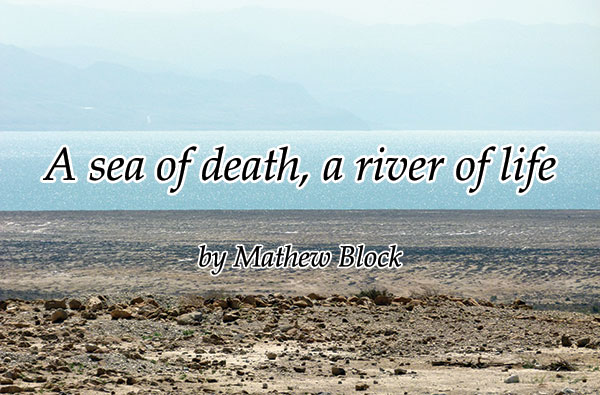
I was lucky enough to visit the Dead Sea when I traveled to the Holy Land in March. It’s a popular destination for two reasons: one, it’s the lowest place on earth at 424 meters below sea level. And two, it’s one of the saltiest bodies of water in the world—so salty, in fact, that (other than some bacteria) nothing can live in the Dead Sea.
Chances are you can think of biblical stories that feature the Red Sea and the Sea of Galilee. But what about the Dead Sea?
Ezekiel once had a vision concerning the Dead Sea. At the time, the Israelites were in exile, the Temple was destroyed, and things looked bleak. But God promised Ezekiel that He would build a new and glorious Temple. From its doors would issue forth a river, a river which would flow down to the Dead Sea and make it pure. “When the water flows into the sea,” Ezekiel writes, “the water will become fresh” (47:8 ESV). Zechariah made a similar prophecy, speaking of the day “living water” would flow out to this sea from Jerusalem (14:8).
These prophecies predict the new covenant in Christ: He tells us He gives “living waters” to those who thirst (John 4:7). This is a water which takes the spiritually dead and brings them to life—the sort of thing we see in baptism. For baptism too is water which brings the dead to life. “Do you not know that all of us who have been baptized into Christ were baptized into his death?” Paul asks. “We were therefore buried with him by baptism into death, in order that, just as Christ was raised from the dead by the glory of the Father, we too might walk in newness of life” (Romans 6:3-4). This water finds what is dead and makes it alive!
 That’s a selection from my column for the March/April issue of The Canadian Lutheran. Read the full article here: “A sea of life, a river of death.” The same issue has my long-feature story on visiting the Holy Land, so watch here for a link to it in the near future.
That’s a selection from my column for the March/April issue of The Canadian Lutheran. Read the full article here: “A sea of life, a river of death.” The same issue has my long-feature story on visiting the Holy Land, so watch here for a link to it in the near future.
———————


